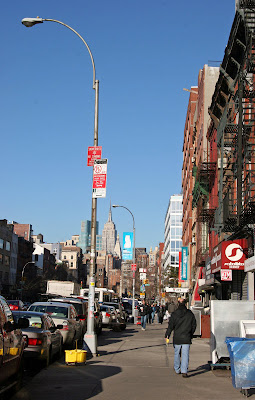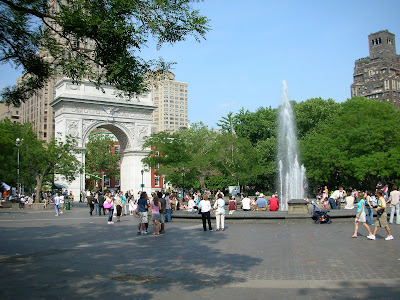
Mae West in Manhattan in 1933
Mae West (1893-1980), born in Brooklyn, NYC, was an American actress, playwright, screenwriter, and sex symbol but perhaps, best remembered for her bawdy double entendres, such as:
"My left leg is Christmas; my right leg is Easter; why don't you come up and visit me between the holidays?""When I'm good I'm very very good. When I am bad, I'm better.""There are no good girls gone wrong. There are only bad girls found out.""I used to be Snow White, but I drifted.""I feel like a million tonight - but one at a time.""There are two things in life I like hard and one of them is eggs.""Anything worth doing is worth doing slowly.""Ten men waiting for me at the door? Send one of them home, I'm tired."And her most famous:
"Is that a pistol in your pocket or are you just glad to see me?" Mae & W. C. Fields in the comedy film classic "My Little Chickadee" (1940)
Mae & W. C. Fields in the comedy film classic "My Little Chickadee" (1940)In 1918, after several high-profile revues, West got her big break in the Shubert Brothers revue "Sometime," opposite Ed Wynn. Eventually, she began writing her own risque plays using the pen name Jane Mast. Her first starring role on Broadway was in a play she titled "Sex", which she also wrote, produced and directed. This notorious show did not go over well with city officials and the theater was raided with West arrested along with the cast.
She was prosecuted on morals charges and, on April 19, 1927, was sentenced to ten days imprisonment for "corrupting the morals of youth."
While incarcerated on Roosevelt Island, she was allowed to wear her silk underpants instead of the scratchy prison issue and the warden reportedly took her to dinner every night and surprisingly was given a two day reduction in the term served for "good behavior."
In 1932, West was offered a motion picture contract by Paramount Pictures. One of her earlier films was "She Done Him Wrong" (1933). The film is also notable as providing one of Cary Grant's first major roles, which boosted his career. Mae claimed she spotted Grant at the studio and insisted he be cast as the male lead. The film was a box office hit and earned an Academy Award nomination for Best Picture. The huge success of the movie is accredited with saving Paramount from bankruptcy. Her next release "I'm No Angel"(1933) again paired her alongside Cary Grant. The film was a tremendous financial blockbuster and was nominated for an Academy Award.
 Mae giving Rock Hudson her "Come up and see sometime" look at the 1958 Academy Awards Show
Mae giving Rock Hudson her "Come up and see sometime" look at the 1958 Academy Awards Show
As well as films, Mae enjoyed a long career on the stage, television, radio and writing and well into her old age she was always ready with her quick wit which has become legend. She died on November 22, 1980 at age 87 and is entombed with her family in Cypress Hills Cemetery, Brooklyn. For her contribution to the film industry, she has a star on the Hollywood Walk of Fame in Hollywood.
And a parting thought from Mae, "You only live once, but if you do it right, once is enough." She sure did it right!
 The Puck Building occupies the block bounded by Lafayette, Houston, Mulberry and Jersey Streets. It was built in 1885, expanded in 1893, and until 1918 was the printing facility of Puck Magazine. The building now contains office space as well as ballrooms for large events on both the ground floor and the top floor. This example of Romanesque Revival architecture features two gilded figures of Shakespeare's character "Puck" as part of the facade.
The Puck Building occupies the block bounded by Lafayette, Houston, Mulberry and Jersey Streets. It was built in 1885, expanded in 1893, and until 1918 was the printing facility of Puck Magazine. The building now contains office space as well as ballrooms for large events on both the ground floor and the top floor. This example of Romanesque Revival architecture features two gilded figures of Shakespeare's character "Puck" as part of the facade. An office stationery company, S. Novick & Son, once occupied the second floor, and notable amongst the firms' salesmen was Alger Hiss, the former assistant Secretary of State who was brought down in a spy scandal in the 1950's which brings to mind 'Puck's' words from Midsummer Nights Dream Act 3, Scene 2, "Lord what fools these mortals be!"
An office stationery company, S. Novick & Son, once occupied the second floor, and notable amongst the firms' salesmen was Alger Hiss, the former assistant Secretary of State who was brought down in a spy scandal in the 1950's which brings to mind 'Puck's' words from Midsummer Nights Dream Act 3, Scene 2, "Lord what fools these mortals be!"














































